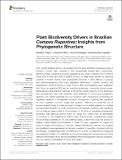Files in this item
Plant biodiversity drivers in Brazilian campos rupestres : insights from phylogenetic structure
Item metadata
| dc.contributor.author | Zappi, Daniela C. | |
| dc.contributor.author | Freire Moro, Marcelo | |
| dc.contributor.author | Meagher, Thomas R. | |
| dc.contributor.author | Nic Lughadha, Eimear | |
| dc.date.accessioned | 2017-12-19T14:30:19Z | |
| dc.date.available | 2017-12-19T14:30:19Z | |
| dc.date.issued | 2017-12-19 | |
| dc.identifier.citation | Zappi , D C , Freire Moro , M , Meagher , T R & Nic Lughadha , E 2017 , ' Plant biodiversity drivers in Brazilian campos rupestres : insights from phylogenetic structure ' , Frontiers in Plant Science , vol. 8 , 2141 . https://doi.org/10.3389/fpls.2017.02141 | en |
| dc.identifier.issn | 1664-462X | |
| dc.identifier.other | PURE: 251802875 | |
| dc.identifier.other | PURE UUID: 33dce961-0d07-4fdb-8151-c39d09b9854a | |
| dc.identifier.other | RIS: urn:30A7559AC08353CC8E0EAD258FDEC4F3 | |
| dc.identifier.other | Scopus: 85040508513 | |
| dc.identifier.other | WOS: 000418250200005 | |
| dc.identifier.uri | https://hdl.handle.net/10023/12356 | |
| dc.description | MMwas funded by the São Paulo Research Foundation (FAPESP 2013/15280–9) at the initial stages of this work. | en |
| dc.description.abstract | Old, climate-buffered infertile landscapes (Ocbils) have attracted increasing levels of interest in recent years because of their exceptionally diverse plant communities. Brazil’s campos rupestres (rupestrian grasslands) are home to almost 15% of Brazil’s native flora in less than 0.8% of Brazil’s territory: an ideal study system for exploring variation in floristic diversity and phylogenetic structure in sites differing in geology and phytophysiognomy. We found significant differences in floristic diversity and phylogenetic structure across a range of study sites encompassing open vegetation and forest on quartzite and on ironstone substrates, commonly termed canga. Substrate was key in structuring floristic diversity with physiognomy having a secondary effect. In contrast physiognomy was more important than substrate in structuring phylogenetic diversity, with neither substrate nor its interaction with physiognomy accounting for significant variation in phylogenetic structure. Phylogenetic clustering was significant in open vegetation on both canga and quartzite, reflecting the potential role of environmental filtering in these exposed montane communities adapted to multiple environmental stressors. In forest communities, phylogenetic clustering was significant only at relatively deep nodes of the phylogeny in forest on quartzite while no significant phylogenetic clustering was detected across forest on canga, which may be attributable to proximity to the megadiverse Atlantic forest biome and/or comparatively benign environmental conditions in forest on canga with relatively deep, nutrient-rich soils and access to edaphic water reliable in comparison to those for open vegetation on canga and open or forest communities on quartzite. Clades representing relatively old lineages are significantly over-represented in campos rupestres on quartzite, consistent with the Gondwanan Heritage Hypothesis of Ocbil theory. In contrast, forested sites on canga are recognized as Yodfels. To be effective, conservation measures must take account of the distinct communities which are encompassed within the broad term campos rupestres, and the differing vulnerabilities of Ocbils and Yodfels. | |
| dc.format.extent | 15 | |
| dc.language.iso | eng | |
| dc.relation.ispartof | Frontiers in Plant Science | en |
| dc.rights | Copyright © 2017 Zappi, Moro, Meagher and Nic Lughadha. This is an open-access article distributed under the terms of the Creative Commons Attribution License (CC BY). The use, distribution or reproduction in other forums is permitted, provided the original author(s) or licensor are credited and that the original publication in this journal is cited, in accordance with accepted academic practice. No use, distribution or reproduction is permitted which does not comply with these terms. | en |
| dc.subject | Campos rupestres | en |
| dc.subject | Canga | en |
| dc.subject | Eastern Brazil | en |
| dc.subject | Phylogenetic clustering | en |
| dc.subject | Rupestrian grasslands | en |
| dc.subject | Substrate | en |
| dc.subject | Vegetation types | en |
| dc.subject | QH301 Biology | en |
| dc.subject | DAS | en |
| dc.subject.lcc | QH301 | en |
| dc.title | Plant biodiversity drivers in Brazilian campos rupestres : insights from phylogenetic structure | en |
| dc.type | Journal article | en |
| dc.description.version | Publisher PDF | en |
| dc.contributor.institution | University of St Andrews. School of Biology | en |
| dc.contributor.institution | University of St Andrews. Centre for Biological Diversity | en |
| dc.contributor.institution | University of St Andrews. Scottish Oceans Institute | en |
| dc.contributor.institution | University of St Andrews. St Andrews Sustainability Institute | en |
| dc.contributor.institution | University of St Andrews. Centre for Evolution, Genes and Genomics | en |
| dc.contributor.institution | University of St Andrews. Centre for Research into Ecological & Environmental Modelling | en |
| dc.identifier.doi | https://doi.org/10.3389/fpls.2017.02141 | |
| dc.description.status | Peer reviewed | en |
This item appears in the following Collection(s)
Items in the St Andrews Research Repository are protected by copyright, with all rights reserved, unless otherwise indicated.

